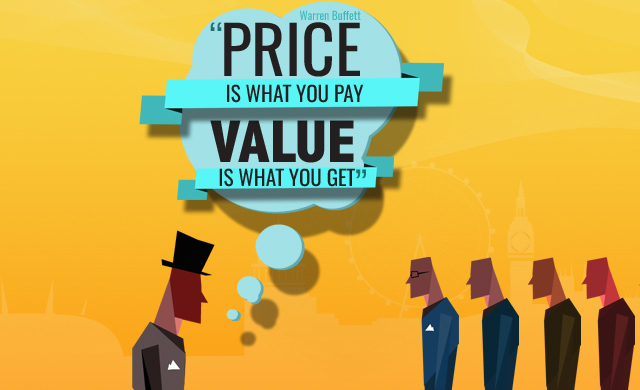Intrinsic value is the discounted value of the cash that can be taken out of a business during its remaining life. This number is going to be highly subjective because the valuer is forced to estimate future owner earnings; the annual sums that can be taken by shareholders without damaging competitive position or unit volume – see Friday’s newsletter.

Estimating the future is never going to be precise, it is bound to be fuzzy. Despite this Buffett urges us to do it as the “only logical way to evaluate the relative attractiveness of investments and businesses” (Buffett’s 1994 letter).
An education
To help us understand why book value is not intrinsic value Buffett draws an analogy with a college education: the cost of the education is the “book value” (ideally this should include the opportunity cost of attending college, e.g. lost earnings from work).
For intrinsic value, in pure economic terms (where we ignore the aesthetic, social, psychological, etc., benefits of education), we estimate the graduate’s lifetime earnings and deduct the amount he/she would have earned without attending college. These annual additional earnings figures are discounted to a present value at an appropriate rate, to give the intrinsic economic value of education.
Some graduates find that book value exceeds the intrinsic value, but in many cases intrinsic value far exceeds book value, confirming a wise allocation of capital at the start of the college course.
The most important lesson is that book value is not relevant when it comes to calculating intrinsic value.
Scott Fetzer’s intrinsic value
If we want to apply this principle to Scott Fetzer the key facts are that £315.2m was paid for a business with $172.6m of book value, “The $142.6 million premium we handed over indicated our belief that the company’s intrinsic value was close to double its book value.” (1994 Letter)
In his 1994 letter Buffett illustrates the difference by showing book value declining between 1986 and 1994 but rising earnings and dividends. Clearly intrinsic value increased (assuming continued sound strategic positioning and managerial quality and therefore good future earnings) – see table.
Table. Contrasting book value and earnings for Scott Fetzer 1986-1994
| $m | Book value (beginning of year) | After-tax income | Dividends to Berkshire Hathaway | |||
| 1986 | 172.6 | 40.3 | 125.0 | |||
| 1987 | 87.9 | 48.6 | 41.0 | |||
| 1988 | 95.5 | 58.0 | 35.0 | |||
| 1989 | 118.6 | 58.5 | 71.5 | |||
| 1990 | 105.5 | 61.3 | 33.5 | |||
| 1991 | 133.3 | 61.4 | 74.0 | |||
| 1992 | 120.7 | 70.5 | 80.0 | |||
| 1993 | 111.2 | 77.5 | 98.0 | |||
| 1994 | 90.7 | 79.3 | 76.0 |
Source: Buffett’s letter to shareholders 1994
Scott Fetzer had large amounts of excess cash when Berkshire bought it, and so was able to pay its parent company $125m in the first year, $84.7m more than owner earnings. Balance sheet value started off being significantly different from intrinsic value, and became increasingly distant over the years:
“Clearly, the intrinsic value of the business has consistently grown… The difference between Scott Fetzer’s intrinsic value and its carrying value [book value] on Berkshire’s books is now huge.” (1994 Letter)
An attempt at valuation using owner earnings
Buffett does not provide us with
…………To read more subscribe to my premium newsletter Deep Value Shares – click here http://newsletters.advfn.com/deepvalueshares/subscribe-1

 Hot Features
Hot Features













